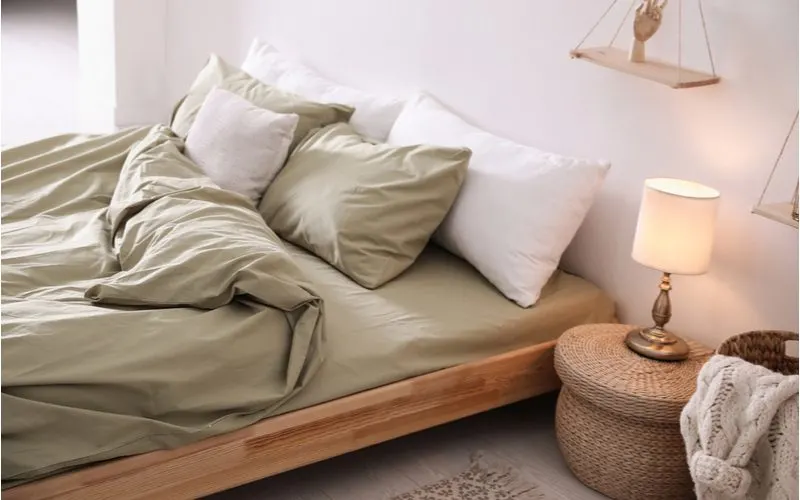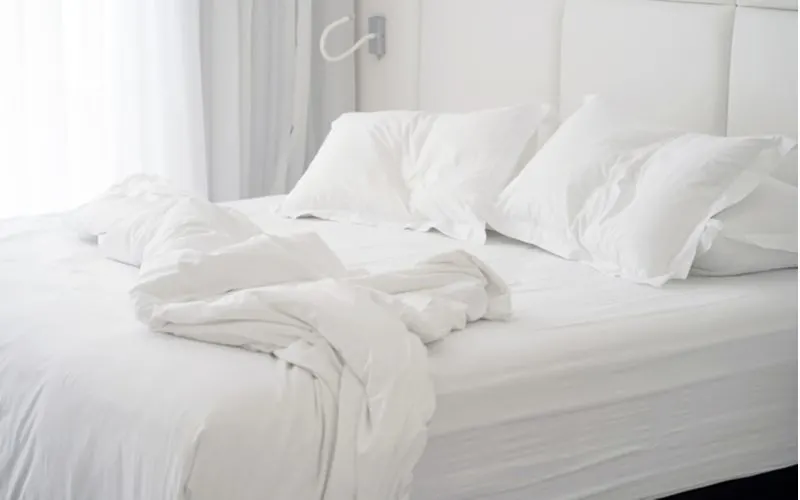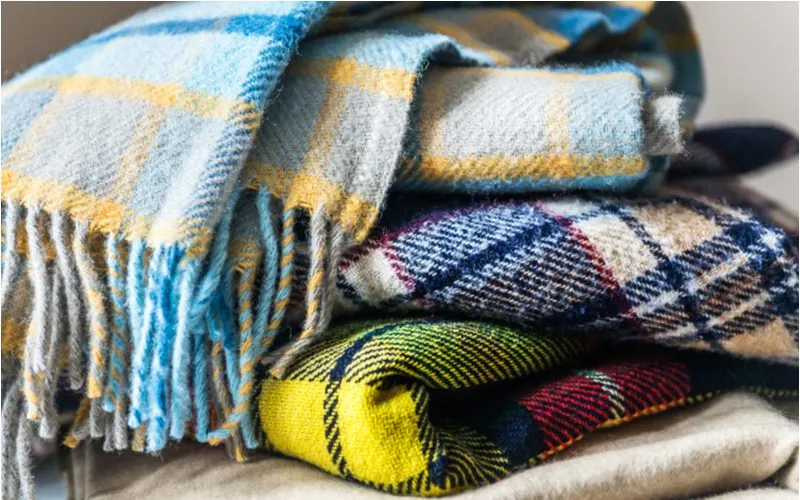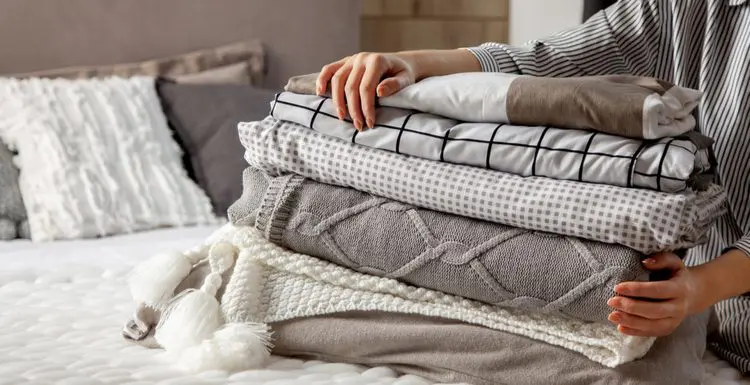Comfort is critical for getting a good night’s sleep, so you want everything in your bed to promote complete relaxation.
When trying to decide between a comforter and a blanket, it is important to keep their differences in mind.
The Short Answer: A Comforter Is Better Insulating

New Africa/Shutterstock
In general, a comforter is warmer than a blanket because its filling has added insulation.
In contrast, a blanket is only single-layered. So the most significant difference between a comforter and a blanket is the layering. Because blankets are single-layered, they are mainly used during warmer seasons.
On the other hand, comforters have at least two layers of cloth with insulating fabrics that provide more warmth and comfort, especially during colder seasons.
Additionally, comforters can serve as bed coverings during the winter. Of course, age, climate, and medical conditions may affect your ultimate choice.
Comforter vs. Blanket: The Details
Let’s dig deeper into the subject so you can make an informed decision.
What is a Comforter?

Lunopark/Shutterstock
A comforter is a thick, fluffy, quilted type of blanket that is usually filled with natural fibers, including fur, wool, silk, and feather. It tends to be less fluffy and flatter compared to its European counterpart, called a duvet.
It is also quilted to help keep the filling in place. It’s ideal for providing warmth and protection during colder seasons. Usually, the warmth rating or fill power is listed on the product’s label. It typically ranges from 200 to 1000.
A warmth rating below 400 is considered summer bedding. While a warmth rating of 800 and above means it’s meant for freezing climates, they are more expensive but very durable. Here are some of the advantages and disadvantages of using a comforter:
Pros
- Most comforters come with matching bed sheets and pillowcases to make your bed design uniform and fashionable.
- You won’t need to have a bed cover because you can use a comforter without one.
- Frequent washing of comforters isn’t necessary compared to blankets.
Cons
- If you have a comforter, tidying up your bed is more time-consuming.
- Once the filling goes flat and wears down, you need to look for a replacement. If you can’t find a comforter matching your sheets, it results in a bedding mismatch.
- Most comforters can’t be washed in your washing machine. Instead, they need dry-cleaning, which can be a hassle to pack and more expensive.
- If you don’t want to dry-clean comforters too often, use cover sheets. However, cover sheets can also be expensive.
Types of Comforters
Comforters are generally categorized based on the fiber and the material used. So, here is the list of different types of comforters that are available on the market:
- Natural Fiber
- Cotton
- Silk
- Wool
- Faux Suede
- Synthetic Blends
- Fleece
- Jacquard
- Down-filled
- Flannel
- Fur
- Polyester
- Satin
What is a Blanket?

Anna Mente/Shutterstock
A blanket is a soft cloth cover that provides warmth when you’re in bed or on the couch. It’s usually made from cotton or wool.
The word “blanket” is derived from the French word “blanc,” which means white because they were made from white wool in the past.
You can use a blanket as a replacement for a lightweight comforter, but it doesn’t have the same insulation capacity as a comforter.
Here are some of the advantages and disadvantages of using a blanket:
Pros
- The materials used to make a blanket are durable, such as cotton, fleece, and wool.
- Blankets are very comfortable to sleep on because they can serve as a bed covering, too.
- It’s effortless to style, and add a decorative cover to your blanket to make matching bedding.
- You can find blankets in many colors and patterns. So, you won’t find it hard to find a blanket that suits your bedroom.
- Since blankets are lightweight, they are easy to clean. Just throw them into the machine like your regular clothes and bedsheets.
Cons
- Since a blanket can look very plain, there’s a need for a cover to add more style.
- Blankets made of wool are expensive.
- It can be challenging to insert a cover alone. You might need the help of another person.
- Since blankets and covers are available in rectangular and square shapes, respectively, it is not easy to find the right cover size for your blanket.
Types of Blankets
The kind of blanket is an essential consideration because it affects the quality of sleep. Of all types of blankets, cashmere is the most comfortable and luxurious fabric for sleeping.
It’s very soft, warm, and durable. Below are some of the common types of blankets available on the market:
- Afghan
- Acrylic
- Cashmere
- Chenille
- Cotton
- Down
- Fleece
- Heated
- Linen
- Microfiber
- Nylon
- Polyester
- Quilt
- Summer
- Throw
- Vellux
- Waffle
- Weighted
- Wool
Differences Between Comforters vs. Blankets

Photographee.eu/Shutterstock
To help you better understand the differences between a comforter and a blanket, here are some of the factors to consider:
Construction
In terms of construction, a comforter is thick bedding with a varying outer cover and insulation filling.
A blanket has a single layer of fabric and is typically rectangular in shape. It’s made of various types of material, with wool and fleece being the most popular.
Warmth
Another important consideration is the warmth a comforter or blanket provides.
Since a comforter is made of synthetic materials and has at least two layers of fabric, it offers more warmth than a blanket. It also has a layer of insulation in addition to its two layers of fabric.
However, an electric blanket can provide more warmth during the winter. The downside is that it uses electricity and comes with its own set of risks.
Storage
When it comes to storage, comforters are challenging to store because of their thick layers. Blankets are lightweight and thin, so they are very easy to keep in your closet.
Allergies
The same material that makes comforters soft, fluffy, and warm traps dust and provides dust mites with a place to thrive. So, if you have allergies, you can find yourself coughing or sneezing when using the comforter.
If you need a comforter despite the allergy, get a zippered cover to keep the dust and mites out. Alternatively, you can use an open-weave cotton blanket or an electric blanket to reduce the symptoms.
Research shows that electric blankets reduce dust mites’ population by 50 percent when used continuously for eight hours. You can also find hypoallergenic blankets to give you a more comfortable sleep experience.
If you plan on purchasing one, ensure that the product is hypoallergenic, as stated on its label. Make sure to wash all the purchased products before their first use. You didn’t know where it was before you found it on the shelf.
Care
Proper care and maintenance of your comforters and blankets are necessary for their longevity.
So, before washing your comforter and blankets, make sure you read the labels for instructions. Usually, comforters need dry cleaning or gentle washing to protect the filling.
Since blankets are made of robust fabrics, they can easily be thrown into your washing machine like regular clothes.
However, you still need to look at the label to check if the product needs careful washing, depending on its material.
Airflow
The batting and filling in your comforter, which offer insulation properties, impede the airflow during the winter.
On the other hand, blankets are purposely loosely woven to keep you cool during warmer seasons.
Cost
The cost of the product depends on its fabric, and the prices per material vary significantly.
For instance, the price of comforters ranges from $50 to a few hundred dollars. The more expensive options use delicate filling and high-end materials.
Generally, blankets are cheaper than comforters due to their construction and more affordable materials. The price ranges from as low as $5 up to fifty dollars.
Frequently Asked Questions
Here are the most common questions about blankets and comforters and their answers.
You can. However, if you’re looking for the kind of warmth that a comforter can give, you will probably need more than one blanket. Though they are sometimes confused, and “blanket” is used as a generic term, they are not the same thing. Both are specific words that describe two different pieces of bedding. These two words are also sometimes used as synonyms. However, quilts are thinner and usually more dense. In terms of warmth, they are about the same, though materials influence this, so it depends on the construction of each product.Can you use a blanket instead of a comforter?
Is a comforter a blanket?
Is it better to sleep with a comforter or quilt?
Comforters vs. Blankets: Which Is Better?
So there you have it—a rundown of comforters vs. blankets. Comforters and blankets serve different purposes.
While they are both excellent options for any room, your decision still comes down to the climate you live in and how warm you want to feel.
If you like to stay warm on the couch while watching movies or you want an easy-to-clean and easy-to-store cover, a blanket is probably a much better choice for you.
A comforter is ideal for cold winter nights because it is purposely built to offer plenty of insulation. Whether you choose one or the other (or both!), make sure to consider their materials, quality, and general practicality.

